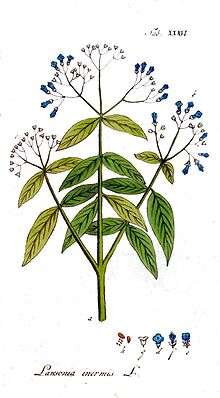
Henna
Henna (Lawsonia inermis, also known as hina, the henna tree, the mignonette tree, and the Egyptian privet) is a flowering plant and the sole species of the Lawsonia genus. The English name "henna" comes from the Arabic حِنَّاء (ALA-LC: ḥinnāʾ; pronounced [ħɪnˈnæːʔ]) or, colloquially حنا, loosely pronounced as /ħinna/.
The name henna also refers to the dye prepared from the plant and the art of temporary body art (staining) based on those dyes (see also mehndi). Henna has been used since antiquity to dye skin, hair and fingernails, as well as fabrics including silk, wool and leather. The name is used in other skin and hair dyes, such as black henna and neutral henna, neither of which is derived from the henna plant.
Historically, henna was used for cosmetic purposes primarily in Ancient India. It was also found to be used in the Arabian Peninsula, South Asia, Carthage and other parts of North Africa, and the Horn of Africa. Bridal henna nights remain an important custom in many of these areas, particularly among traditional families.
Body
Body or BODY may refer to:
Physical entities
Music
Literature and publishing
Film and television
Glossary of pottery terms
This is a list of pottery and ceramic terms.
A
B

Teairra Marí
Teairra Marí (born Teairra María Thomas; December 2, 1987) is an American singer-songwriter, dancer, hip hop model and actress. At the age of 17, Jay Z signed her to Def Jam and she released her first album, Teairra Marí. After disappointing sales, she was let go from her recording contract in the middle of production for her second album Second Round. In 2008, she returned to the music scene with the Pleasure P-assisted single "Hunt 4 U". After constant leaks, she was forced to re-record and re-title a second attempt at her second album At That Point. In 2010, she starred in the film Lottery Ticket alongside rappers Bow Wow and Ice Cube. Since 2010, she has released several mixtapes including features from Nicki Minaj, Soulja Boy, and Gucci Mane.
In 2014 Teairra was featured on the song and the music video "Where This Light Goes" along with Tiffany Foxx and Angelina Pivarnick.
Biography
Early life and career beginnings
Hina
Hina may refer to:
See also

Artò
Artò is a frazione (and parish) of the municipality of Madonna del Sasso, in Piedmont, northern Italy.
Overview
It is a village located some km west from the Lake Orta.
History
Since 1928 Artò was a separate comune (municipality).
References
External links
![]() Media related to Artò at Wikimedia Commons
Media related to Artò at Wikimedia Commons

Artà
Coordinates: 39°42′N 3°21′E / 39.700°N 3.350°E / 39.700; 3.350
Artà is one of the 53 independent municipalities on the Spanish Balearic island of Majorca. The small town of the same name is the administrative seat of this municipality in the region (Comarca) of Llevant.
Population
In 2008 the municipality of Artà had a population of 7,113 recorded residents within an area of 139.63 square kilometres (53.91 sq mi). This equates to 50.9 inhabitants per km2. In 2006 the percentage of foreigners was 13.2% (890), of which Germans made up 3.9% (262). In 1991 there were still 136 illiterates in the municipality. 1,292 inhabitants had no education, 1,675 only a primary school certificate and 1,210 had secondary school leaving certificates. The official languages are Catalan and Spanish (Castilian). The Catalan dialect spoken on the island is known as Mallorquí.
Geography
Location
Artà lies in the northeast of the island of Majorca, around 60 km from the island's capital of Palma. The Massís d’Artà, the highest and most compact massif in the eastern mountain chain of the Serres de Llevant, occupies more than half the area of the municipality. The municipality is located on the western part of peninsula of Artà and is bordered in the west by the Bay of Alcúdia (Badia d’Alcúdia), and in the north by the Mediterranean sea where its coast lies opposite the neighbouring island of Minorca. The coast of Artà stretches for 25 kilometres and, so far, has escaped being developed. Particularly noteworthy are the beach and sand dune formations of sa Canova d’Artà, the flat coastal strip near the settlement of Colònia de Sant Pere, the high rocky coves of the Cap de Ferrutx and a large number of smaller bays that extend from s’Arenalet des Verger to Cala Torta.
Podcasts:

